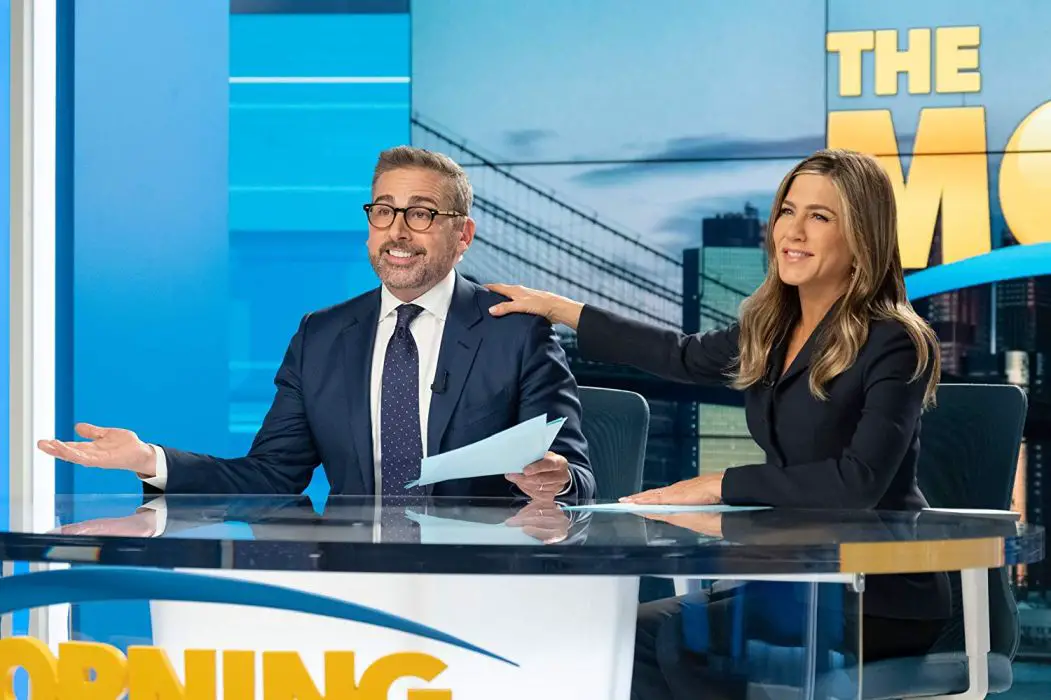The Streaming Wars & The Apple TV+ Gamble

Film critic, Ithaca College and University of St Andrews graduate,…
Our veritable streaming wars are increasing in intensity the more players that get added to the conflict. Back in the halcyon days of 2015, when Amazon and Hulu were just figuring out this whole “producing and distributing movies” thing and Netflix was still the unwelcome industry disruptor, streaming services were fledgling glimpses of what the future might hold.
In just five years, there’s been a tulip fever for streaming services, with Shudder, Showtime, the Criterion Channel, NBCUniversal’s Peac*ck, Curiosity Stream, Mubi, YouTube Premium, CBS All Access, DC Universe, and surely a dozen or so more services cropping up. These streaming platforms represent massive amounts of money being poured into procuring and home-growing hit shows and movies to bring in as much of an audience as it takes to turn a profit. And because the statistics behind all of this are virtually unknown, it’s still a mystery how much revenue all these subscribers represent.
Now, HBO has a streaming service planned for 2020, HBO Max. While Max promises to be more generalist, including HBO’s entire back catalogue, the services get more niche from there — there’s CrunchyRoll for your anime fix; Mubi for your procured indies and classics; Hi-Yah! for all your martial arts movies; IMDb TV for watching Apocalypse Now with commercial breaks; and Crackle if you hate yourself.
Don’t Look Down
The pool of challengers to Netflix’s throne over the streaming world includes HBO Max, but the real titans are Disney’s and Apple’s streaming services. As we move into November, Disney+ and Apple TV+ are hounds baying at the door to our wallets. But how much potential do they really have to disrupt this streaming gold rush?
The sheer amount of money being shoved at original programming makes the entire endeavor feel like a Looney Tunes gag. CBS All Access, Apple TV+, and all the other second-tier services are like Wile E. Coyote, racing out across a chasm in pursuit of the Road Runner, the only thing preventing them from falling being that they never look down.
Netflix spent just over $12 billion on original content in 2018, according to Variety. But now serious contenders are on the horizon and the service is losing subscribers. In July, the company reported losing 126,000 sets of eyeballs in the U.S. alone. Unfettered, Netflix doubled down on content production, raising another $2 billion in debt to produce movies and TV to keep the service’s programming at the center of our cinematic and cultural conversation.

It’s unclear how much of Netflix’s billions of dollars in content investments go toward funding originals, but originals seem to be the main benefactor. In this age of peak TV, funding new shows (and films) eats up a lot of costs. In 2017, for instance, the company took a leap into uncharted territory: A big-budget Hollywood tentpole that never screened in theaters, Bright.
The Will Smith action-fantasy movie Bright cost the service $90 million for production, not counting marketing, which is still short of superhero movie numbers (pared-down offerings Logan and Venom cost $97 and $100 million, respectively). Later, Netflix’s surprise sidequel, The Cloverfield Paradox, was a $50 million purchase — they didn’t even produce it in-house, just tossed money at Paramount when it was clear they had a dud on their hands. This year’s The Irishman, whose awards push should outclass even that of the service’s critical darling Roma, cost $140 million and then some.
And that’s just the films — Godless is reported to have cost Netflix $60 million. The short-lived Sense8 cost about $9 million per episode. The Get Down cost $120 million per season. The Crown cost $130 million per season.
Most of these shows have been canceled since their premieres. These are high-profile, expensive series, promoted ceaselessly and featuring big-name gets like Jeff Daniels, the Waschowskis, and Baz Luhrmann, yet they only lasted a season or two before cancelation. (Though wouldn’t it be amusing if Netflix released earning reports and it turned out they tripled their investment on, of all things, The Get Down?)
Even Stranger Things, a series that, like The Crown, is still running on Netflix, proved expensive. Ironically modeled on low-budget sci-fi and horror eighties adventures, the Duffer brothers’ show cost $6 million per episode for its first season, $8 million for its second. For reference, that’s how much Game of Thrones’ “Blackwater” episode cost, and it’s roughly half a million shy of what Star Trek: Discovery costs CBS All Access per episode. It’s a wonder the smaller guys — YouTube Premium, DC Universe — can afford to stay in the game.
Still, we have years left before the money begins to dry up on the less popular services, and even then, some virtual unknowns have started up and stayed active for years without a significant consumer base, seemingly fueled by the raw grit of dreams alone. (I’m looking at you, Screambox and Hayu.)
The Big Three
Netflix, Amazon, and Hulu aren’t going anywhere in the coming year. They’re the Big Three, and they’ve each been around long enough to accrue goodwill and loyal consumers. Up-and-comers might make dents in the armor, but they won’t take down the rider.
Netflix especially profits from ease and familiarity. Though reporting from Business Insider shows Netflix’s catalog dropping from 7,285 movies and TV shows in 2010 to 5,579 titles in 2018, that’s still nothing to scoff at. When Disney+ announced their lineup on Twitter and the thread seemed to go on forever (that poor intern who posted them…), by the end of the debacle they had announced a total of 619 titles, a mere fraction of Netflix’s library.
Most of those are movies, too — Netflix has twice as many series alone on its platform as Disney+ will have titles to stream. Scalewise, the service is like a really expensive local library, while Netflix is the New York Public Library, where four rooms are reserved for maps and I get lost trying to find the bathroom.

Amazon meanwhile has a comfortable package alongside Amazon Prime, so online shoppers are easy subscribers. Of the Big Three, Prime’s also the most critic- and theater-friendly. The studio produced Manchester By the Sea, which received six Academy Award nominations, including Best Picture, won Best Actor, and enjoyed a long stay in theaters. Just the previous year, Netflix struggled to gain the same respect, acclaim, and awards attention for its then-biggest prestige picture, Beasts of No Nation.
Since Kenneth Lonergan’s runaway sad-dad, dead-kid hit Manchester By the Sea in 2016, Amazon Prime produced all manner of hefty awards contenders. Paterson, I Am Not Your Negro, The Big Sick, City of Ghosts, You Were Never Really Here, Beautiful Boy, and Cold War all represented serious arthouse gambles, and critics and awards shows permitted them because unlike Netflix, Amazon Studios still adheres to a routine theatrical run.
As for Hulu, which has been absorbed by the House of Mouse, that isn’t going anywhere either. It’s set to be the home for all the content too adult to show on Disney+, which will decidedly be a family network. Handmaid’s Tale; I Love You, America with Sarah Silverman; and Castle Rock are among that platform’s most well-known slate. Yet there’s another, deeper reason why these services will remain in the race despite all the young blood.
Everyone Loves Bird Box Memes
In 1942, the Japanese had won a string of battles, and World War II raged on in the Pacific. Before the tide turned against the Japanese, Emperor Hirohito said, “The fruits of victory are tumbling into our mouths too quickly.”
That’s how Netflix probably felt in 2018, when its industry clout was growing without threat. Critics were beginning to accept its films as bona fide awards contenders thanks to Alfonso Cuarón, the Coen brothers, and Steven Soderbergh. And any potential disruptors were just shadows passing in the mist of the valley below.
The company had only faced minor controversies, but those were to be expected: Netflix threatened theaters, which was always going to make the film world uncomfortable; it incentivized unhealthy watching habits; it rewarded and in fact planned for fewer engaged viewing experiences; and it never disclosed its viewer count until people made a bunch of memes about Bird Box — and it made people lose their goddamn minds.

Whatever moviegoing will look like in 2025, it’s a pretty safe bet that Netflix will still be part of the industry. So how do they stick around, and what did they figure out before anyone else?
You could almost measure Netflix’s history in terms of its major series licenses. The Office will continue to dominate the service until it leaves at the end of 2020. Friends will leave sooner than that. In lieu of those hits, Netflix bought the rights to Seinfeld, an interesting get as the audience that binges Seinfeld is probably demographically very different from the audience that will watch hours on end of Chandler with his head stuck in a turkey, probably. (I don’t know what happens on Friends; I don’t watch the show.)
Meanwhile, At Apple TV+
Content acquisition is key. A consumer isn’t going to sign up for a streaming service carrying completely original content — or, at least, in theory.
At Apple TV+, things are looking dire. The plane’s about to take off, and she’s flying without instruments. Or wings. But she’s got plenty of landing gear — Apple can probably afford several lifetimes of dud streaming services.
Their four shows vying to be flagships include the Jason Mamoa post-apocalyptic series See, which looks like that Cloud Atlas version of the future, except everyone’s lost their eyesight. There’s also the subversive bio-series Dickinson, starring Hailee Steinfeld with an odd accent and John Mulaney with fake sideburns, of course, capitalizing on the market-tested IP of… Emily Dickinson.

Their next series comes from a team of Battlestar Galactica and Star Trek writers: For All Mankind, an alternate history drama in which the space race continued after the Soviet Union Apollo 11’d before us. The show’s biggest star is Joel Kinnaman, and he’s flanked by a cast of unknowns.
Anyone with even a vague knowledge of budgeting will tell you not to go for the post-apocalypse story and the space race period drama out of the gate. They’re bad investments, and even if somehow, the viewership is there, it still feels to me like Apple is premiering Waterworld and John Carter on the same weekend. But the most questionable is perhaps The Morning Show. It’s about the behind-the-scenes drama of a morning talk show and stars Jennifer Aniston, Reese Witherspoon, and Steve Carell. It isn’t even a comedy.
The Morning Show and See will both cost $15 million per episode, as much as the season finale of Game of Thrones. See already has a second season approved, for a total cost of $240 million. Apple and Disney entering the streaming game means that price tags have gone way up for series. See’s $240 million isn’t a TV budget; it’s a movie budget, and it’s more than what the first Avengers movie cost.
As of yet, Apple has not bought the rights to stream other content. It’s solely originals. Some lesser-promoted titles include an elephant nature doc, an untitled Oprah Winfrey project, a Ghostwriter reboot, and an M. Night Shyamalan show, with content from Steven Spielberg and a Ryan Reynolds/Will Ferrell Christmas Carol musical in production for the service.
Apple TV+ feels less like a streaming service and more like a science experiment, out to measure exactly how many people are willing to pay $4.99 a month for the least content imaginable. The great discovery of the first six years of streaming empires has been that viewers don’t seek out original content, but they’re won over by it. Come for The Office, stay for House of Cards.

That Apple is refusing to host any recognizable IP (Ghostwriter was a children’s mystery show from the ’90s, so it stretches the definition of “recognizable”) seems like a recipe for disaster. Successful streaming services are built on a stable of existing content mixed with a lot of promising originals. Putting fewer than a dozen shows on your new streaming service doesn’t leave much room for misfires. If their service doesn’t release viewership numbers and manages to stay afloat for more than a few years, it’ll probably be because any debt the service gets in can be easily compensated by its parent company.
If it seems like I’m unfairly bashing Apple TV+, I’d like to remind you that you probably already own a Macbook, an iPhone and maybe an Apple Watch. You might pay for Apple Music. It owns Shazam and Beats Electronics and acquires a new company every two to three weeks. In the next few years, they’ll release self-driving cars. It’s a trillion-dollar company. Are you rooting for their new streaming service to succeed?
Off To The Arms Race
HBO Max will be premiering next year. It has shored its defenses not only with its HBO originals, but also with geek giggle juice The Big Bang Theory and several behemoth BBC shows, including Doctor Who. And for the first time ever, every Miyazaki movie will be available in one place to stream — they’ve manufactured a novel draw through licensing.
As for the Big Three, they still have their draws. But something alarming to consider is the lack of robust original content they’ve put out in the six-plus years since House of Cards debuted. Sure, everyone loves Stranger Things, and critics and awards shows have been going ga-ga for The Marvelous Mrs. Maisel and The Handmaid’s Tale. But these are all finite narrative series with limited appeal. None of these is a demographics-sweeping ER, Grey’s Anatomy, or Game of Thrones that will last for seven-plus seasons. In six years, Netflix has not produced a single long-running hit to rival the beloved shows they syndicate.
At least Disney+ knows the right selling point: themselves.
Marvel movies. Marvel TV shows. Star Wars. Badass nature documentaries. The Simpsons. Disney’s content is original in that it’s home-grown, but it isn’t new. The company is a brand unto themselves, which is how they can get away with a streaming service of nearly entirely Disney-branded films and series. How many other streaming services can do the same? Disney’s library might be a Great Lake compared to Netflix’s veritable sea of content, but hey, the Great Lakes are pretty big, and for $6.99 per month you can watch Chris Pine pilot a small boat across one of them in 2016’s completely forgettable The Finest Hours, soon to be streaming on Disney+.
Will you subscribe to Apple TV+, Disney+, or HBO Max? Sound off in the comments below.
Does content like this matter to you?
Become a Member and support film journalism. Unlock access to all of Film Inquiry`s great articles. Join a community of like-minded readers who are passionate about cinema - get access to our private members Network, give back to independent filmmakers, and more.
Film critic, Ithaca College and University of St Andrews graduate, head of the "Paddington 2" fan club.










